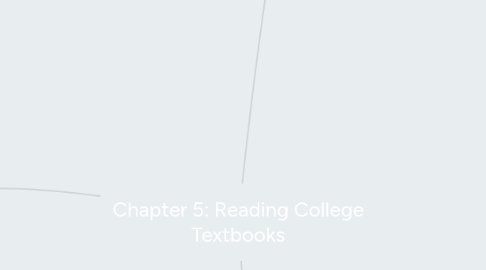
1. 5.3: Improving Your Reading
1.1. Monitoring Your Reading
1.1.1. Reread the material
1.1.2. Clarify the reading
1.1.3. Use a study group
1.2. Developing Your Vocabulary
1.2.1. Notice & write down unfamiliar terms during the text preview
1.2.1.1. Flash cards
1.2.1.2. List terms/ definitions
1.2.2. Think about context when coming across challenging words
1.2.2.1. Use context clues to define
1.2.3. Consider a word's parts
1.2.3.1. Analyze
1.2.3.1.1. Roots
1.2.3.1.2. Prefixes
1.2.3.1.3. Suffixes
1.2.3.2. Use if context clues don't work
1.2.4. Use glossary or dictionary
1.2.4.1. Glossary: Help students define certain words
1.2.4.2. Use dictionary if there isn't a glossary
1.2.5. Use new words in your writing and speaking
1.2.5.1. Flash cards for reviewing definitions
1.2.5.2. You'll know the word if you use it a few times
2. 5.1: Active Reading
2.1. Previewing
2.1.1. Read Learning Objectives
2.1.1.1. Main ideas/skills obtained from reading
2.1.2. Read Summary
2.1.2.1. Import. ideas
2.1.3. Read Title
2.1.3.1. What do I know about this subject?
2.1.4. Mapping
2.1.4.1. Preview strategy
2.1.4.2. Make wheel/ branching structure
2.1.4.3. shows relationship between main and secondary ideas
2.1.4.4. Visual Learners
2.1.5. Outlining/Listing
2.1.5.1. Read/Write Learners
2.1.5.2. Step by step image
2.1.5.3. Identify
2.1.5.3.1. Headings/subheadings
2.1.5.3.2. Main/sub topics
2.1.5.3.3. Terms
2.1.6. Chunking
2.1.6.1. Divide terms into categories
2.1.6.2. Remembered in chunks of 5, 7 or 9
2.1.7. Flash Cards
2.1.7.1. Portable test questions
2.1.7.2. Memorize
2.1.7.2.1. Dates
2.1.7.2.2. Definitions
2.1.7.2.3. Formulas
2.1.7.3. Visual/ Kinesthetic Learners
2.2. Marking
2.2.1. Annotate
2.2.1.1. Notes about the reading
2.2.1.2. Margin notes
2.2.2. Read before marking
2.2.2.1. Read the section first
2.2.2.2. Identify
2.2.2.2.1. Import. Ideas
2.2.2.2.2. Concepts
2.2.3. Think before marking
2.2.3.1. Reflect
2.2.3.2. Instructor emphasized terms?
2.2.3.3. Most import. ideas?
2.2.3.4. Avoid over marking
2.2.3.5. Will it be on the test?
2.2.4. Take notes w/ marking
2.2.4.1. Add notes to map/outline/list
2.2.4.2. Don't just mark
2.2.4.3. Read to understand section
2.2.5. Don't just highlight/underline
2.2.5.1. Over Marking
2.2.5.1.1. Form of procrastination
2.2.5.2. Won't be able to identify key concepts
2.3. Reading w/ Concentration
2.3.1. Quiet study place
2.3.1.1. Avoid distractions
2.3.1.2. Go somewhere away from noise
2.3.1.3. Avoid studying in bed
2.3.1.3.1. You're conditioned to sleep
2.3.2. Power off/mute electronics
2.3.2.1. Won't be tempted to check it
2.3.2.1.1. Don't be tempted to check email/social media/chat/etc.
2.3.2.2. Disconnect from WIFI
2.3.3. Read in blocks & take short breaks
2.3.3.1. Be able to process reading easier
2.3.4. Set goals
2.3.4.1. Reward yourself
2.3.4.2. Motivate yourself during study time
2.3.5. Physical activity during breaks
2.3.5.1. Trouble concentrating/staying awake
2.3.5.2. Think positively about study goals
2.3.6. Actively engage in the material
2.3.6.1. Write study questions
2.3.6.2. Reread confusing parts
2.3.6.3. Make not to ask instructor for help
2.3.7. Focus on import. sections
2.3.7.1. Pay attention to...
2.3.7.1.1. First/last sentences
2.3.7.1.2. Bold/Italicized words
2.3.8. Understand the words
2.3.8.1. Use glossary
2.3.8.2. Use a dictionary
2.3.9. Reviewing
2.3.9.1. Use 5 senses
2.3.9.2. Read aloud
2.3.9.3. Take items off your list as you do them
2.3.9.4. Make diagrams/maps/outlines
2.3.9.4.1. Post around living space
2.3.9.4.2. Visualize during test
2.3.10. Organize
2.3.10.1. Keep maps/outlines/lists/flash cards
2.3.10.1.1. Use them as you read
2.3.10.1.2. Add as you go
3. 5.2: Strategies for Reading Textbooks
3.1. Textbooks Aren't Created Equal
3.2. Math Texts
3.2.1. Do practice problems
3.2.2. Less reading
3.2.3. More examples
3.2.4. Learn formulas
3.3. Science Texts
3.3.1. Term based reading
3.3.2. Don't put in own words
3.3.3. Primary source documents
3.4. Social sciences/Humanities Texts
3.4.1. History, Economics & Political Sciences
3.4.2. Options/theories
3.4.3. Read primary sources
3.4.4. Ask questions about the subject

